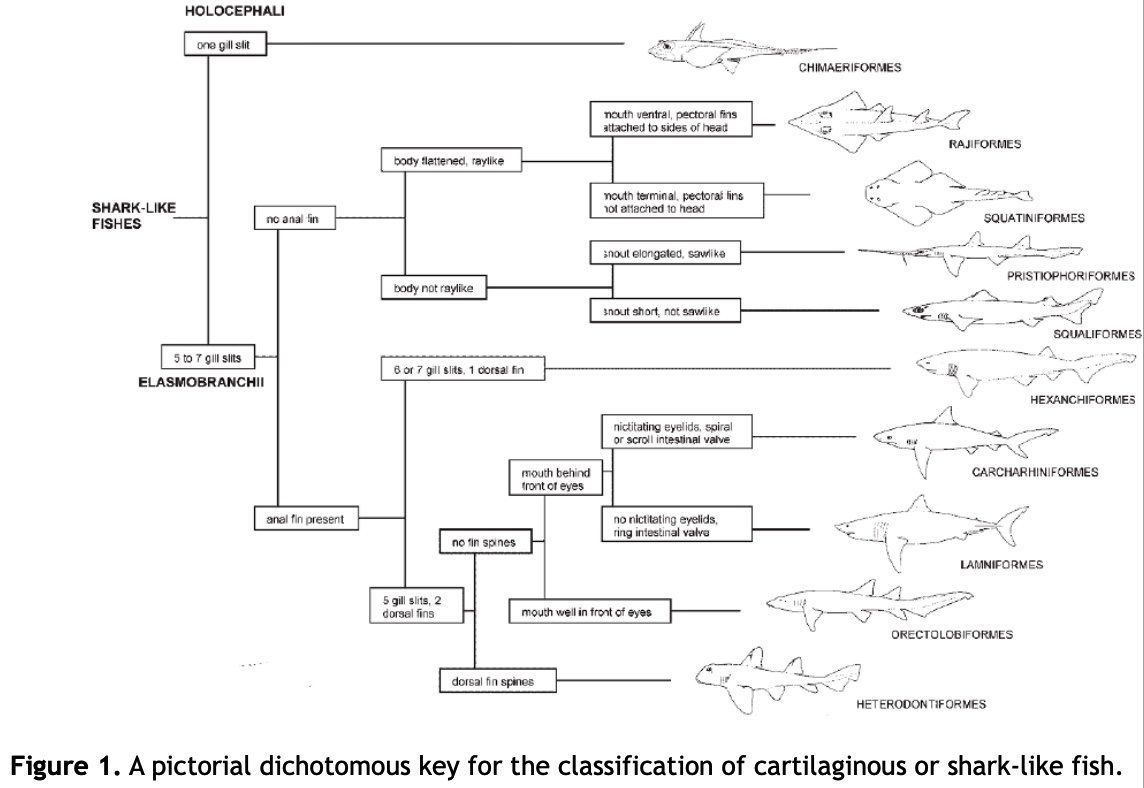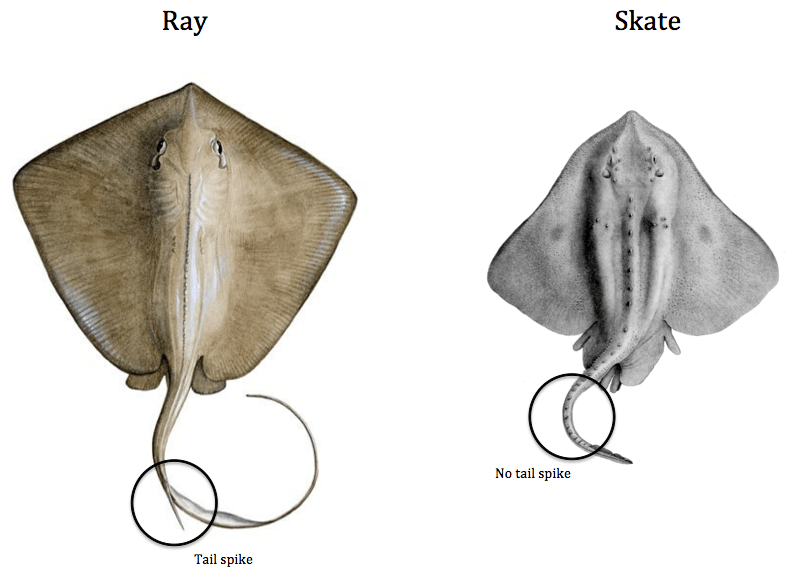Elasmobranchs
Sharks, Skates & Rays
Elasmobranchs (sharks, skates, and rays)
Sharks are top predators of the marine environment and so provide a crucial role in maintaining ecosystem function.
Sharks and rays have biological characteristics and an ecological role which suggests they could be particularly vulnerable to fishing pressure as they include some of the latest maturing and slowest reproducing of all vertebrates, resulting in very low population growth rates with little capacity to recover from overfishing and other threats such as pollution or habitat destruction All elasmobranchs are predators and must exist at the top of the food chain. Their abundance is therefore relatively small compared to groups situated in lower trophic levels.
As a group, elasmobranchs present an array of challenges for fisheries management and conservation. Life–history characteristics make sharks a fragile resource, and more susceptible to overfishing than most teleost (bony) fishes. The high mobility of many species, sometimes involving transboundary migrations, incorporates another level of complexity to their assessment and highlights the need for proper knowledge about stock delimitation and dynamics if adequate management is to be implemented. Elasmobranch fisheries assessment is complicated further because of a general lack of baseline information about their fisheries throughout the world.
Will you help to protect sharks in Irish waters? Help improve our knowledge on the distribution, reproductive status, and foraging behaviours of sharks in Irish waters so we can provide better recommendations for the sustainable management of Irish marine ecosystems. Learn how to identify the different species and Log your records in the Observers App.
Elasmobranch Classification:
Sharks and their relatives are collectively classed as chondrichthyes, or cartilaginous, fishes. They are not only one of the oldest but are also one of the most ecologically diverse vertebrate lineages with up to 1,115 described species worldwide to date. Chondricthyes evolved at least 420 million years ago and rapidly diversified to occupy the top-predator niche of aquatic food webs, both freshwater and marine. The class chondrichtyes is further divided into the two subclasses: Elasmobranchii (sharks, rays and skates) and Holocephali (chimaeras, sometimes called ghost sharks). For taxonomical purposes, the cartilaginous fish are included in class Chondrichthyes, further classification of which is as shown below. (Fig. 1).
Irish waters are home to 72 species of cartilaginous fish, which is over half the number of species found in Europe. The cartilaginous fish include sharks and their relatives, so called because of their skeleton which is composed primarily of cartilage. Irish waters provide important areas for spawning and nurseries for many of these species, and supports both sedentary, as well as migratory species in a wide range of marine habitats. The most recent species to be recorded in Irish waters was of a smooth hammerhead shark (Sphyrna zygaena), in June 2019, on-board the R.V. Celtic Voyager during WESPAS 2019 (Western European Shelf Pelagic Acoustic) Survey.
Irish waters contain elasmobranch species in every habitat, from coastal waters to deep-sea and supports both sedentary/ resident and highly-mobile migratory taxa . Unfortunatly, these waters are also the focus of some of the most intense fishing in Europe, with fishing fleets from Spain, France, Portugal and the Netherlands fishing withing our Exclusive Economic Zone (EEZ) and fishing vessels from Japan and the South Pacific fishing for tuna species, such as Atlantic bluefin (Thunnus thynnus ), just outside the EEZ. Pelagic long-liners for tuna species, poses a serious threat to the suvival of shark species worldwide, with up to 100 million sharks killed unintentionally as bycatch in these fisheries every year.
What is the difference between a skate and ray?
Skates and rays are species of fish, closely related to sharks that are dorso-ventrally flattened. This gives them an added advantage to be able to glide along the sea-floor. Rays and skates are very similar in appearance however, there are differences. Rays give birth to live pups (viviparous) whilst skates produce egg cases (oviparous) that are distinctive to the species. Skates have a tail that is stockier and does not have a stinging spine. Rays have a thinner tail and sometimes have a stinging spine.
Skates and Rays bury themselves under sand on the sea-floor to protect themselves from predators. There are two breathing holes called spiracles located near their eyes which allow them to breath when covered in sand. The presence of these spiracles means that rays have the ability to rest on the sea-floor whereas most other sharks must keep swimming to keep water moving across their gills or else they will not be able to breath. Their mouth is on the underside of their body which enables them to feed on benthic animals.
In reference to anatomical structures, skates have a prominent dorsal fin, while rays have a reduced or no dorsal fin at all. Skates also have more flesh in their tails with no spines compared to rays with thin, whip-like tails and a stinging barb. The barb and the poison they carry serve as a protection for the ray from intruders or predators. Skates have no barbs but rely on the projection formations that stick out like thorns on their backs for their protection.
Rays are often in the shape of a kite with a smooth tail while skates have a more round or triangle shape with small fins in the tail. In terms of comparison in size, rays are considered larger than skates. Teeth are also another category of difference between the two. Skates have small teeth while rays have plate-like teeth that are used for crushing food.
Sharks
List of Services
-
Angel shark
Angel shark (Squatina squatina)
- Max length 2.5 m\
-More than 90% of total shark tagged by Inland Fisheries Ireland (IFI) showed Tralee and Clew Bay, Co. Kerry being the centre of he species distribution. in Ireland.
- Greyish brown dorsal colouration. Small white and dark spots. Some populations have light white lines creating a pathwork pattern dorsally, ventrally white.
-
Blue sharkList Item 1
Blue Shark (Prionace glauca)
- Max length 3.8 meters.
- Irish range - "hot-spots" off south and west coasts.
- Slim body, long snout, blue with white underbelly.
-
Basking sharkList Item 2
Basking Shark (Cetorhinus maximus)
- Max length 10 meters
- Irish range - sighted in waters offall coasts but mainly in the south and west.
- Second largest fish in the word, often at surface filter feeding on plankton.
-
Porbeagle sharkList Item 3
Porbeagle Shark (Lamna nasus)
- Max length 3.5 meters
- Irish range - "hot-spots" off the north and south coasts.
- Robust, petrol coloured mackerel shark.
-
Shortfin mako SharkList Item 4
Shortfin mako Shark (Isurus oxyrinchus)
- Max length 4 meters
- Irish range - recorded along the south coast of Ireland.
- Streamlined with pointed snout., large first dorsal and pectoral fins, small second dorsal, anal and pelvic fins.
-
Smooth hammerhead shark
Smooth hammerhead shark (Sphyrna zygaena)
- Max length 5 m
- Occurs worldwide to higher latitudes than any other hammerhead species. In the Atlantic,; from Nova Scotia to the Virgin Islands and from Brazil to southern Argentina in the west, and from the British Isles to Côte d'Ivoire, including the Mediterranean Sea.
-Hammerhead shape head that bugles forward but has no central indentation
-
Thresher shark
Thresher shark (Alopias vulpinus)
-Max length 7.6m (usually 2–5m)
-Look for Huge tail; may breach
Skates
List of Services
-
Common/ Blue skateList Item 1
Blue skate (Dipturus batis)
- Max length (3m)
- Current range generally in deeper waters off Iceland, the western seaboard of the British Isles, including the Celtic Sea, along the edge of the continental shelf, and in the Bay of Biscay and Atlantic Iberian waters.
-Greyish brown dorsal colouration. Variable pattern of white and dark blotches,
-
Flapper SkateList Item 3
Flapper Skate (Dipturus intermedia)
- Max Lenght 2.5 m
-Once found globally, distribution now restricted solely to Iceland, Norway, and the norther North Sea the western British Isles and the Celtic Sea.
-Males have two small but pronounced thorn patches on the upper side of the wing tips (the alar thorns).
-
Undulate SkateList Item 4
Undulate Skate (Raja undulata)
- Max length 1 m
- It is found from southern Ireland and England to Senegal, and in the western Mediterranean.
-The upper side of the skate can be a multitude of different shades of brown. You will find that it is covered in long wavy brown lines that are accented with rows of white spots.
-
White SkateList Item 2
White Skate (Rostroraja alba)
- Max lenght (2 m)
-Rarely encountered in Irish waters, confined to the Tralee Bay region and to a lesser extent, Galway Bay.
_ Long pointed snout (more so in adults), giving it a "bottlenose" appearance.
-
Long-nosed skate
Long-nosed skate (Dipurus oxyrinchus)
- Max lenght 1.5m
-Northeast Atlantic from Norway to Morocco including the Mediterranean Sea.
- Both surfaces light brown in juveniles.
Adults darker to grey on both surfaces.
Pattern of light and dark spots dorsally.
Mucous pores marked with black dots and streaks
Rays
List of Services
-
Atlantic torpedo rayList Item 2
Atlantic Torpedo Ray (Tetronarce nobiliana)
- Max length 1.8 meters
- Widely distributed in cool waters on both sides of the Atlantic Ocean.
-Dark chocolate to purplish brown above, without spots, white below, but with edges of disc and pelvic fins of same hue as upper surface, tail with irregular dark margin.
-
Common stingrayList Item 1
Common stingray (Dasyatis pastinaca)
- Max length 2.5 m
-Southern Norway to the northern Mediterraneanvii including the western Balticiii and the Black Sea to Madeira and the Canary Islands.They have also been seen in the eastern Pacific along the coast of North America.
-Upper surfaces greyish, olive or brown; underside white with a wide greyishbrown to blackish margin.







